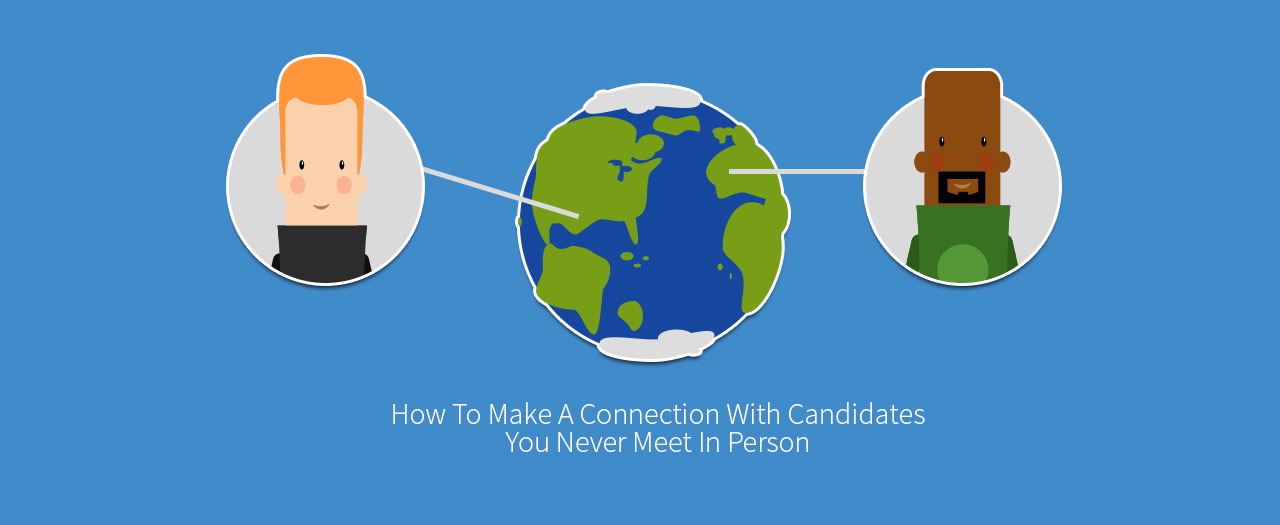It’s no secret that, here at Spark Hire, we love video interviews. They create a better candidate experience, give you a better insight into your hiring options, and are just easier for everyone involved. But there is one thing that makes many organizations skeptical about using video interviews in their hiring process: the idea that you can’t create a real connection with candidates you never meet in person.
That myth stems from the fact that companies have a hard time reaching candidates, even in a traditional interview setting. A 2014 Jibe survey found that 57% of HR professionals have a hard time keeping candidates engaged throughout the application process. And 55% of HR pros struggle to create a connection with candidates.
Logically, if it’s that hard to begin to build a relationship with someone you meet face-to-face, it must be twice as hard to do that via a computer screen, right?
Wrong.
In reality, video interviews offer unique opportunities to better connect with candidates. It takes a little bit of creativity and effort to get your new hires off on the right foot. That way, they can transition smoothly into their new position at the company.
What’s the key to creating a solid foundation for the employment relationship during video interviews? It’s simple: create a more human candidate experience.
Job seekers need to feel and believe that there’s an actual person on the other side of the screen who is reading, considering, and interested in their application. They want to get to know you just as much as you want to get to know them.
Here are four ways you can surpass candidates’ expectations by creating a strong, real connection with them via video:
1. Be a person, not an email address
In many ways, technology has made our lives infinitely easier. Video interviewing wouldn’t even be possible without such advances. But in other ways, it’s also made us lazy when it comes to being actual humans.
Now when job seekers apply for an open position, they get an automated response telling them that their application was received. While automation saves you time, it sends the signal to candidates that their employment fate is in the hands of a machine.
This immediately disconnects them from the organization. They have no personal contact to reach out to if they have questions or issues regarding the process. At best, they might an automated message telling them to send an email to an impersonal address like [email protected].
In fact, the number one problem with the application process for many job seekers is automation. A 2015 survey by CareerBuilder found that 57% of job seekers feel the process is more difficult because of its lack of human contact. So ask yourself: are the few minutes you save by letting the computers handle communication worth the terrible candidate experience it creates?
How to do better:
Add a few personal touches here and there. Instead of sending out form emails updating candidates about their status in the application process, write individualized ones. Use their name. Also, reference details from their resume or list any connections they may have within the organization based on their education history. And don’t forget to include your professional contact information so they can reach out if need be.
In the CareerBuilder survey above, 59% of candidates said they had a more positive impression of the company if they received a personalized email during business hours. Just 36% had a better impression after getting an automated email.
It also helps to put a face to the name. Consider sharing your professional headshot in your email signature or even sending out a video of you telling candidates how excited you are to review their application.
You could create a video template for each stage of the interview process. Send a quick “Congratulations!” with instructions for what comes next. Have fun with the videos and include aspects of your company culture. Different videos can feature different people within the company.
Anyone from the CEO to the office receptionist is a great option. Talk to candidates like you would if they were a regular employee. That way, they’ll have a friendly face, and not black and white text, to connect with each step.
2. Give future co-workers a face
Whom we work with has a significant impact on how much we love our job. In a 2015 Virgin Pulse survey, 40% of employees said that their co-workers were what they loved most about their organization. That makes perfect sense considering these are the people with whom we spend most of our working hours.
However, during the interview process, current employees are noticeably absent. In the CareerBuilder survey, just 15% of job seekers said they’d spent time with their future co-workers before they took the job offer.
In some situations, candidates who go through video interviews don’t visit the office before you hire them. In that case, they aren’t chatting with employees in the elevator. They can’t see what decorations people put on their desks or get an idea for what interests everyone has in common. They don’t get a complete picture of what the company culture is like and that they’d fit in at the office.
But that’s because you’re not taking the opportunity to show them.
How to do better:
Find ways to introduce co-workers during the hiring process. One particularly easy method is to have each employee record a short introduction video. Then, depending on which department a candidate would be working with, you can send them the videos and let them know the workforce.
Encourage employees to share more than just their position and how long they’ve been with the company. You’re looking to create a clearer idea of what it’s like to work with these people, not share the credentials on their resume. Have employees talk about their favorite pastime or what type of music they listen to while at work.
Another way to get future co-workers involved in the hiring process is to create an applicant/employee buddy system. Turn to your team who exemplify the company culture and values and see if they’d be interested in mentoring candidates.
It doesn’t have to require a lot of their time — a short phone call to answer questions and give advice would be enough. The idea is to connect them with real people. Someone they won’t have to go through awkward introductions with on their first day of work.
And treat this responsibility with respect; the employees who decide to get involved are becoming ambassadors for your employer brand. Thank them and reward them for helping out. Something as simple as a free catered lunch for every candidate they mentor or a shorter day on Friday once in a while are great ways to acknowledge their time.
If the location isn’t an issue, you can go one step further and invite candidates to a company function. Whether it’s the weekly softball game or happy hour, gives candidates the chance to immerse themselves in the company culture and experience it first hand. And don’t think the hiring team needs to be there. That way, candidates can get to know employees without feeling like their professional skills are being judged.
3. Stop lurking on social media
Social media platforms have become an essential part of both the job search and the hiring process. Another 2015 CareerBuilder survey found that 52% of employers use social media to research candidates.
You’re turning to candidates’ social media profiles to find out more about them. You’re looking beyond LinkedIn to create a complete picture of candidates.
Yet aside from sending a friend request to gain access to their profiles, recruiters and hiring managers rarely interact with candidates on social media. Essentially, you’re just creeping on job seekers’ profiles, trying not to make yourself known.
But job seekers know you’re out there, and it seems a little rude, not at least to say hello.
How to do better:
The point of social media is — you guessed it — to be social. Stop hiding in the shadows and start interacting with candidates. If they don’t already, encourage them to follow you. And don’t be afraid to reach out beyond LinkedIn. Twitter and Facebook have countless professional and industry groups to which your candidates probably already belong. Get in there and start posting.
Also, interact with candidates’ posts. You don’t have to retweet the cute puppy videos they like, but follow and comment on their professional content. If they share a particular industry-specific article, suggest another that they might enjoy. That way they’ll know you’re not just interested in hiring them, but also in creating a relationship.
You can also create groups candidates can join that center around your hiring process. They can go there with questions and provide their feedback about the entire process. It also gives them an excellent opportunity to connect with others who are going through the same thing they are.
4. Show them you care about what happens after the decision is made
If you want to create a real bond with candidates, show them you care about what happens to them once the hiring process ends. That means helping them succeed in their career even if that doesn’t include a job at your company.
Yet, for some reason, organizations don’t believe there’s a place for feedback in the hiring process. And it’s letting candidates down. A 2015 LinkedIn survey found that 94% of job seekers want to receive feedback about how they did during the interview, but only 41% had ever gotten any.
What’s worse, in many cases, candidates aren’t even told why they didn’t receive an offer. In the Jibe survey, 51% of job seekers expected to get some information about why they weren’t hired, but only 16% did. Basically, you’re telling them you’re cutting all ties with them without any warning.
How to do better:
Give candidates feedback. Let them know what they did right and what they could work on for future roles. Be specific without getting too personal. For instance, don’t just say a candidate “wasn’t a good fit.” Let them know if they didn’t have enough experience with the required software. And give them suggestions on how they can improve.
Not only will candidates thank you for the input, but it will also keep the relationship you’ve built with them alive and well. The previous 2015 LinkedIn survey found that a job seeker was four times more likely to consider future employment opportunities with a company if they received feedback during their original interview process.
If you do decide a candidate isn’t right for that particular position, let them know you’ll keep them in mind for future opportunities. File away their resume with notes you learned from their original interview, and return to it when new openings come up.
Reach out with information about similar positions. Even if they’re no longer looking for a job, they’ll appreciate that you thought of them. Who knows, the gesture could be enough to woo them away to your company.
Creating a connection with candidates who you only meet via video interviews is possible. If you understand all the technology available, you can even make a stronger bond than you could with a traditional interview. It’s worth your while to think of ways to improve your candidate experience. After all, if you want these candidates to turn into long-term employees, it’s best if you set a strong foundation well before you hire them.
—












